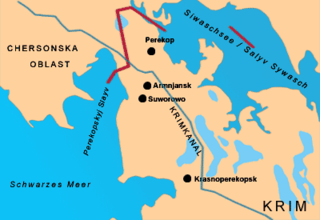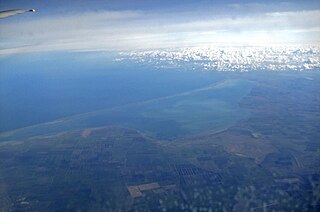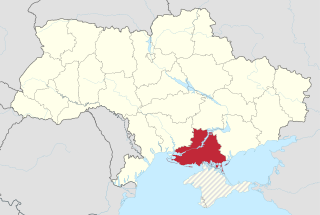
The Sea of Azov is an inland shelf sea in Eastern Europe connected to the Black Sea by the narrow Strait of Kerch, and sometimes regarded as a northern extension of the Black Sea. The sea is bounded by Russia on the east, and by Ukraine on the northwest and southwest. It is an important access route for Central Asia, from the Caspian Sea via the Volga–Don Canal.

Crimea is a peninsula in Eastern Europe, on the northern coast of the Black Sea, almost entirely surrounded by the Black Sea and the smaller Sea of Azov. The Isthmus of Perekop connects the peninsula to Kherson Oblast in mainland Ukraine. To the east, the Crimean Bridge, constructed in 2018, spans the Strait of Kerch, linking the peninsula with Krasnodar Krai in Russia. The Arabat Spit, located to the northeast, is a narrow strip of land that separates the Syvash lagoons from the Sea of Azov. Across the Black Sea to the west lies Romania and to the south is Turkey. The population is 2.4 million, and the largest city is Sevastopol. The region has been under Russian occupation since 2014.

The Russo-Turkish War of 1735–1739 between Russia and the Ottoman Empire was caused by the Ottoman Empire's war with Persia and the continuing raids by the Crimean Tatars. The war also represented Russia's ongoing struggle for access to the Black Sea. In 1737, the Habsburg monarchy joined the war on Russia's side, known in historiography as the Austro-Turkish War of 1737–1739.

The Isthmus of Perekop, literally Isthmus of the Trench, is the narrow, 5–7 kilometres (3.1–4.3 mi) wide strip of land that connects the Crimean Peninsula to the mainland of Ukraine. The isthmus projects between the Black Sea to the west and the Syvash to the east. The isthmus takes its name of "Perekop" from the Tatar fortress of Or Qapi.

The Bay of Arabat,, is in the southwestern Azov Sea in eastern Europe.

Kherson Oblast, also known as Khersonshchyna, is an oblast (province) in southern Ukraine. It is located just north of Crimea. Its administrative center is Kherson, on the northern or right bank of the Dnieper river, which bisects the oblast. The oblast has an area of 28,461 km2 and a population of 1,001,598. It is considered the 'fruit basket' of the country, as much of its agricultural production is dispersed throughout the country, with production peaking during the summer months.

The Syvash or Sivash, also known as the Putrid Sea or Rotten Sea, is a large area of shallow lagoons on the western edge of the Sea of Azov. Separated from the sea by the narrow Arabat Spit, the water of the Syvash covers an area of around 2,560 km2 (990 sq mi) and the entire area spreads over about 10,000 km2 (3,900 sq mi). The Henichesk Strait is its eastern connection to the Sea of Azov. The Syvash borders the northeastern coast of the main Crimean Peninsula. The central and eastern Syvash were registered as wetlands of Ukraine under the Ramsar Convention. Since the 2022 Russian invasion of Ukraine, the entire Syvash has been occupied by Russia.

Taurida Governorate was an administrative-territorial unit (guberniya) of the Russian Empire. It included the territory of the Crimean Peninsula and the mainland between the lower Dnieper River with the coasts of the Black Sea and Sea of Azov. It formed after the Taurida Oblast was abolished in 1802 during Paul I's administrative reform of the territories of the former Crimean Khanate, which were annexed by Russia from the Ottoman Empire in 1783. The governorate's centre was the city of Simferopol. The name of the province was derived from Taurida, a historical name for Crimea.

The Kerch Peninsula is a major and prominent geographic peninsula located at the eastern end of the Crimean Peninsula.

Tuzla Spit or Kosa Tuzla was a long narrow peninsula or sandy spit in the eastern part of the Strait of Kerch which extended from Cape Tuzla to the north-west in the direction of the city Kerch for almost 11 kilometres (6.8 mi).

The Arabat Fortress, built in the 17th century by the Ottoman army, stands at the southernmost part of the Arabat Spit. Its purpose was to guard the spit and Crimea from invasions. It was in use, with intermissions, until the Crimean War of 1853–1856.

The spits of the Sea of Azov are narrow peninsulas of sand, silt and shells in the Sea of Azov. They are as long as 112 km, 45 km, 31 km, 30 km and 23 km. Their total length exceeds 300 km which is larger than the width of the sea.

Henichesk Raion is one of the five administrative raions (districts) of Kherson Oblast in southern Ukraine. Its administrative centre is located in the city of Henichesk. Population: 118,059.

The Chonhar Peninsula is on the northern coast of the Syvash, and in the Kherson province of Ukraine.

Strilkove is a Ukrainian village in Henichesk urban hromada, Henichesk Raion, Kherson Oblast. In 2013 its population was 1,415, and was predominantly ethnic Russian.
Shchaslyvtseve is a village in southern Ukraine. The community is located on the Arabat Spit and is geographically in Crimea, but administered as part of Henichesk Raion, Kherson Oblast. It belongs to Henichesk urban hromada, one of the hromadas of Ukraine.

The Henichesk Strait is a narrow strait which connects the Syvash with the Sea of Azov. It separates the Arabat Spit from the Ukrainian mainland.

The Isthmus of Ak-Monay or Isthmus of Parpach is a narrowing of the Crimea Peninsula to a 17-km width between the Gulf of Feodosia to the south and Sivash and the Bay of Arabat to the north. The isthmus connects Kerch Peninsula to the rest of Crimea.

Lacy's campaign to Crimea was a military expedition from May to October 1737 by the Don army under the command of Field Marshal Peter Lacy, along with Cossacks and Kalmyk auxiliary cavalry led by Prince Galdan-Narbo, against the forces of the Crimean Khanate led by Fetih II Giray during the Russo-Turkish War of 1735–1739. The battles culminated in Russian victory at the Salgir River in Crimea on July 12, 1737, and in the vicinity of Karasubazar on July 14.

























